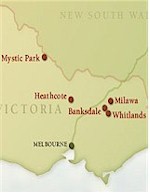
In 1885 John Francis Brown, aged 18 planted ten acres of mostly Riesling, Muscat and Shiraz grapes on his Milawa property, located in the lower reaches of the King Valley in North East Victoria
Milawa Vineyard is the birth place of the Brown Brothers company, the first Brown Brothers wines were released in 1889. Surrounding the cellar door, Milawa Vineyard is the fruit source for renowned wines such as Patricia Noble Riesling, Shiraz Mondeuse & Cabernet and Dolcetto. It is also home to Brown Brothers’ winemaking facilities where grapes are received, crushed and made into quality wine. The current expanse of Brown Brothers vineyards, now located throughout Victoria, are as varied as the wines and wine styles.

Within a 50km radius of Milawa, climatic conditions range from cool alpine areas to lush temperate valleys to sun drenched plains. Each of the vineyards have been selected on the basis of their suitability for the variety or wine style. Varietal diversity through the Brown Brothers range provides a point of difference and offers consumers the ability to experiment across a range.
Brown Brothers Whitlands Vineyard
One of Australia's highest and coolest vineyards Whitlands was planted initially with several varieties and extensive experimental vines to determine the impact of soil and climate on ripening and flavour development. The outstanding fruit has been Pinot Noir, Sauvignon Blanc, Pinot Grigio, Pinot Meunier and Chardonnay for sparkling wine base. While small parcels of Chardonnay and Pinot Noir, are left to ripen fully for table wine, these form only small parcels and only reach their full potential in warmer years. Riesling and Sauvignon Blanc also excel in this slow ripening environment, developing complex lifted aromas and flavour. Future developments are expected to reflect the success of sparkling wine and the cool climate, aromatic varieties.
Brown Brothers Milawa Vineyard
The traditional original vineyard has historically grown an extensive range of varieties, but with the development of the King Valley, the emphasis has been on the success factors of the vineyard - Riesling for our luscious dessert wine, Noble Riesling and Mondeuse for our Shiraz Mondeuse and Cabernet. Dolcetto covers the entire King Park Vineyard (4.85ha) with another 8.28ha at Milawa. Graciano plantings have also been increased with approximately 12.2ha now in the ground. The Hurdle Creek Vineyard which had 6ha of Riesling for Noble Riesling has been expanded with a further 18.3ha.

Brown Brothers Banksdale Vineyard
An ambitious new vineyard of 143 hectares, begun in 1995. The site has been carefully chosen for these varieties, being midway between the coolness of Whitlands and the warmer valley floor. The desire is to achieve highly structured, flavoursome fruit, which will add depth and complexity to existing fruit sources from contracted growers in the adjacent valleys.
Brown Brothers Mystic Park Vineyard
In the Sun drenched Murray Valley, the Company's warmest growing site that has become crucial in the development of generous flavoured fruit such as Tarrango, Orange Muscat, Flora, Dolcetto and Crouchen. These varieties thrive in this environment and regularly produce good crops of excellent fruit. The vineyard also grows excellent crops of Shiraz for table wine, Grenache for Port production with Colombard and Shiraz regularly contributing to the consistency of our softpack wine.
Brown Brothers Heathcote Vineyard
Set on the ridge of the Mount Camel Range. The rich volcanic Cambrian soil and central victorian climate is ideal for producing great quality red wine fruit. Varieties planted are suited perfectly to the Heathcote vineyard as all prefer the warmer climate. Initial crop of Shiraz, Merlot and Sangiovese indicate the Heathcote Vineyard will become a cornerstone of Brown Brothers red wine quality. Shiraz is the largest with 3 crops. Durif - was planted in 2001 and has completed it's first vintage which was a fantastic vintage.
The Cellar Door tradition has been nurtured by the Brown family, growing with it and their business over successive generations. When John Charles Brown took over the reins of Brown Brothers in 1934 he fostered the tradition of the Tasting Room at Cellar Door - a place where visitors could call into the winery, try his wines and share some country hospitality and a love of wine with he and his family.






